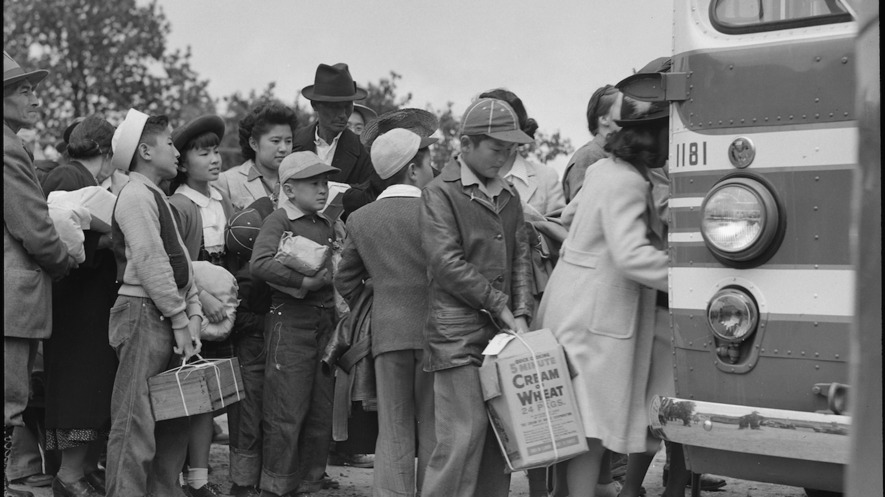On December 7, 1941, Japan attacked Pearl Harbor. It was an American Navy base in Hawaii. About 20 ships and 300 planes were destroyed. The attack killed more than 2,000 soldiers and sailors. Within a few days, the United States entered World War II and declared war on Japan and Germany. The war involved most of the countries in the world.
President sends Japanese-Americans to special camps
After Pearl Harbor, many Americans became very afraid of a Japanese invasion. In February 1942, just two months after Pearl Harbor, President Franklin Delano Roosevelt signed Executive Order 9066. It was aimed at people whose families were from Japan. It said that they could not live along the West Coast. They had to live in special camps away from the Pacific military zone. The order had two purposes. The first was to prevent spying. Many people thought that Japanese-Americans might give military information to Japan. The second was to protect Japanese-Americans from being hurt. At the time, many Americans were angry at the Japanese.
The military zone was along the Pacific Ocean in Washington, Oregon and California.
Two-thirds of those sent to relocation centers were born in America
Roosevelt's order affected 117,000 Japanese-American people. Two-thirds of them were born in the United States. People who were born in Japan were called the Issei. The Nisei were the second generation and were born in America. At the time of Roosevelt's order, there were 70,000 Nisei American citizens. Within weeks, all Japanese-Americans were ordered to report to centers near their homes. It did not matter if they were citizens or not, young or old, or rich or poor. Soon they were sent to special camps outside the military zone. These were called relocation centers or internment camps.
Life was very different
For example, Japanese-Americans in western Washington State went to a gathering point at the Puyallup Fairgrounds near Tacoma. They lived in a cowshed at a fairgrounds or a horse stall at a racetrack for the next several months. Next, the Japanese-Americans were taken to permanent relocation centers. These were often in remote areas far from home. Some of them were in Idaho, Utah, Arizona and Arkansas.
Children went to school, but life was very different. Four or five families had to live together. They ate together in dining halls and there were few jobs. People who made trouble were sent to a special camp at Tule Lake, California.
Fighting unit showed how patriotic Japanese-Americans were
In 1943 and 1944, the government organized a fighting unit of Japanese-Americans soldiers. It was called the 442nd Regimental Combat Team. They won the most medals for bravery in World War II. Many Americans had claimed that Japanese-Americans were loyal to Japan. But these soldiers show how patriotic Japanese-Americans were.
As the war ended, Japanese-Americans were allowed to leave the relocation centers. Some people returned to their hometowns. Many others went to live in new places.
Some people think the relocation centers were like concentration camps. During World War II, Nazi Germany forced Jews to live in concentration camps. They were kept in terrible conditions and were given little food. In 1988, lawmakers passed a law. It apologized to Japanese-Americans for the internment and said it was unfair. The law also gave $20,000 to each person who was interned.
Guns at the guard towers pointed inward
After the war, a Japanese-American was told they were put in the internment camps for their own protection. The person asked if that was the case, why were they not allowed to leave. "Why were the guns at the guard towers pointed inward, instead of outward?"
